
|   |

|   |
 e-mail: leelakaverivenkat@gmail.com Message of peace from Dhauli-Kalinga Photos courtesy: Odisha Tourism February 26, 2020 With untimely rains calling the shots, the postponed Dhauli -Kalinga Mahotsava 2020, proceeded without weather playing tricks again from Feb 10-12. After the peace oath, with V.I.P's holding aloft flaming torches facing the Peace Pagoda atop the hill, at the site where, in the aftermath of the bloody Kalinga war, Emperor Ashoka became Dharma Ashoka converting to Buddhism, a joint curtain-raiser offering of Pallavi as a tribute to Guru Kelucharan Mohapatra by Orissa Dance Academy and Srjan Bhubaneswar was excellently thought out. With two good minds, Aruna Mohanty and Ratikant Mohapatra guiding, the large expanse of the stage, at three levels, was fully utilized, bringing out the excellently trained dancers from two institutions - wisely functioning in independent groups - though in simultaneity as part of one large frame. Each group got chances to be in the centre, on the flanks and right on top. The movements blended beautifully and to listen to the music of Bhubaneswar Misra with Guru Kelucharan on pakhawaj uttering ukkutas for Pallavis in Shankarabharanam, Hamsadhwani and Kirwani created a deep sense of nostalgia. 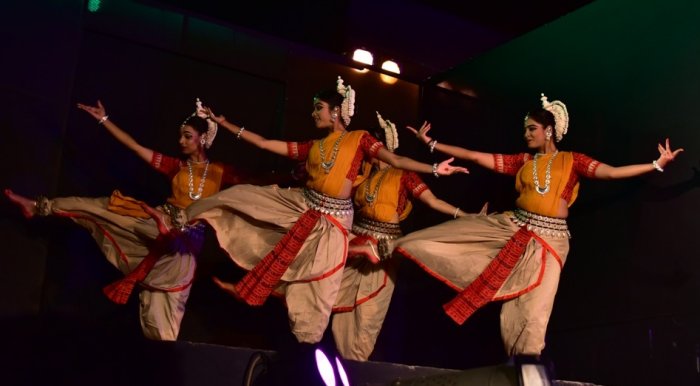 Orissa Dance Academy 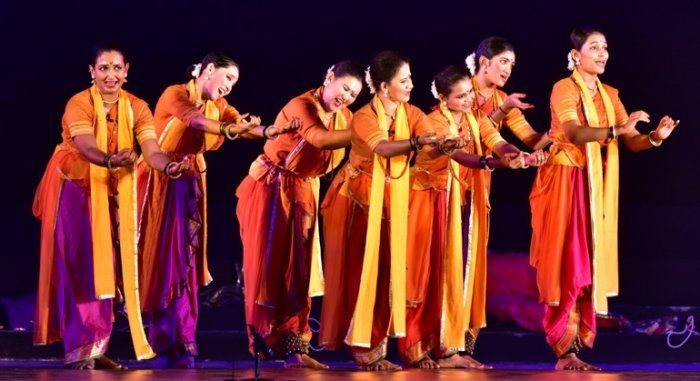 Rajashree Shirke & group Founder-Director of Lasya Centre for Dance, Rajashree Shirke who has acquired a name for her Kathak productions inspired by the old Katha vachak style, took a theme based on Maharashtra's Varkari worship tradition, tracing courtesan Kanhopatra's journey from a Nagara Vadhu selling her beauty to the highest bidder to a devotee of Vithala at Pandarpur. But the contrary pulls that surely must have attended a deha-prem state to one of Ishwaraprem failed to come out in the linear treatment which in an overdose of histrionics, lost sight of the Kathak which was missing completely. Also the accompanying music required better singing from one of the two singers in particular. Whether due to too much editing of a larger work to fit the time frame, Rajashree Shirke's usual skill with her productions was missing. Astad Deboo's offer with his group capturing through Contemporary Dance a feel of the great Mahatma, was, to say the least, 'Gandhian' in its approach to the message which never lost sight of artistic restraint. Imaginatively devised and elegantly presented, the action centered round four principles Gandhi stood for- respect and tolerance for all, of strength lying not in physical ability but mental toughness, of the need to stand apart from the crowd no matter how difficult and of acknowledging the tragedy of educated people misbehaving and the arrogance of the intellectual. It never fails to amaze one to see students from Salam Balak Trust (three of them in this group) and others from less privileged sections of society so efficiently trained by Astad. The choreography, with dancers in simple white dhotis, saw Astad himself performing in his meditative very slow style, his body stances defying all laws of gravity and age, with the students performing alongside or round him - movements like the Attakalari Kalasam and the stick dance and the group walking with the stick suggestively conveying ideas of the Salt March, of unbending will and of superhuman endurance displayed during the civil disobedience movement. Nothing could equal the creative brilliance and strong message in the concluding freeze, with three dancers donning masks (crafted by the dancer disciples themselves) of Large Ears, Eyes and the central person a Nose and large closed Mouth representing the "hear not, see not, speak not evil' motto of Gandhiji totally in sync with peace considering foot-in-mouth utterances of the day. And the music blend from the west and the east was most evocative. 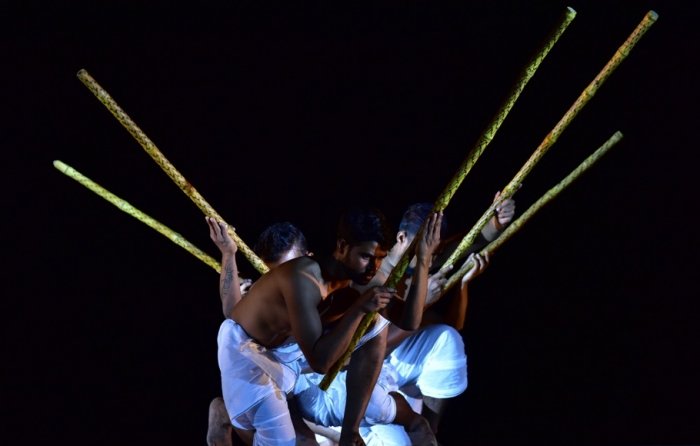 Astad Deboo's group 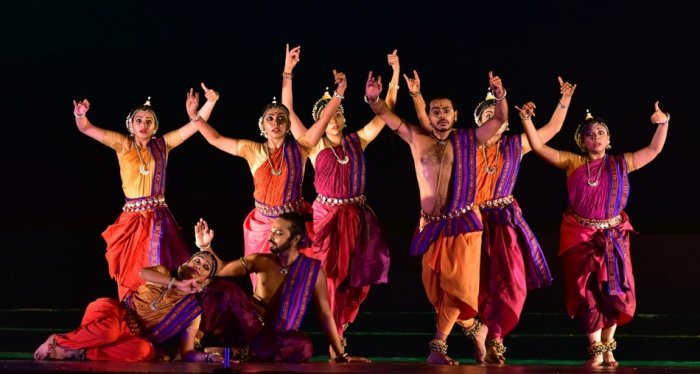 Sharmila Biswas group The second day's start was equally in tune with the festival message, with youngsters from Orissa Art Academy presenting 'Shanti Mantra' choreographed by Ramesh Chandra Jena, Prashant Behera and Rudraprasad Swain. This fine invocation to peace saw the Gotipua group of the Academy also participating holding aloft the pot of plenty and invoking the peace message through flowers, water and fire. Four young groups danced with perfect understanding of space and freezes patterned by the pyramid formations at the rear with all the Bandha Nritya poses. Dance director for Rituparna Ghosh's award winning film Chitrangada, Sharmila Biswas, Artistic Director of Odissi Vision and Movement Centre, believes in trying to understand the grassroots level of Odisha's art identity, while experimenting with new works. Sharmila Biswas' originality stems from expanding Odissi's movement repertoire by bringing within its stylized ambit and grammar, aspects inspired by other art forms and literature of Odisha. Inspired by Ranga Puja of Natya Sastra, her group began with Abahani 'invoking and inviting the Divine within oneself' followed by Ganesh Vandana invoking Vighna Iswara, remover of obstacles. The music by Sangeeta Gosain, including chanting passages, had been composed by consulting scholars and practicing priests of Odisha, with scholarly guidance from Jagannatha Panda, Sudhakar Dash, Niroda Dash, Rajendra Samantray and Lakshmi Narayan Rathasharma. In many respects these rituals in different Indian traditions and areas follow certain common procedures along some peculiar to a region. One appreciated the meditative quality and sense of joy in the presentation. Next item Kalashree based on the music of Debashish Sircar with rhythmic contribution by Dhaneswar Swain was the idea of movements emerging from the chauka - the central concern of the Odissi technique - a stance out of which emerge so many other positions and steps. Intelligently conceived and at a time when the chauka is getting less prominence in the dance than it should, Sharmila's work was a reminder of how technique was conceived. The concluding item Manav Maya with Srijan Chatterjee's music composed with advice from Ramahari, made a metaphor of the maya mriga which Sita lusted after, starting a whole process of misfortunes for herself and the family. The episode was made a metaphor of life itself - full of mirages people pursue to no effect. "Treta Jugore Rama Avatara", "Dhiredhamante Sundara Harini"- it was a nonstop pursuit of an optical illusion, the choreography influenced by traditional theatre styles of Odisha. One must credit the students for rendering it most convincingly. 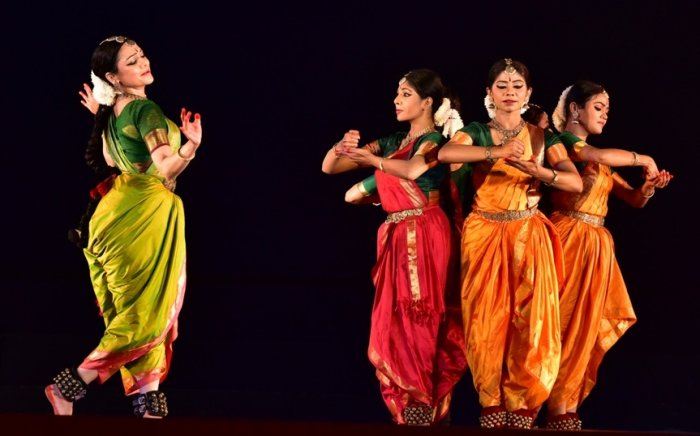 Rama Vaidyanathan & group Rama Vaidyanathan's Bharatanatyam projection began with Manikkavachakar's Tiruvempavai verses set to Purvikalyani and Karaharapriya by Sudha Raghuraman. The verses are in the form of a wakeup call to late sleepers that the sun is shining and it is time to start the day by visiting the temple to have a darshan of Lord Shiva. The group of dancers led by Rama with wide eyed wonder taking in the splendor of the lord made a striking start. The next item based on Adi Shankara's Bindu with verses from Saundarya Lahari and Punyananda Natha's Kamakal Vilasa, made use of abstract dance in expressing the tantric philosophy (that Shankara subscribed to) of the female principle venerated as an intrinsic part of Shiva, and of Shakti's causal role in the creation of the phenomenal world, the sacred point of creation being the Bindu as the pulsating energies of Shiva and Shaki expand and contract. Based on music composed by G.S Rajan in ragas Kalyani and Chandrakauns, the dance for expressing tantric philosophy took on lines preferring the triangle and the inverted triangle geometry, the abstract dance movement lines with the morsing vibrations used freely in the music mixing beautifully. Such concepts expressed in dance provide scope for evolving, as ideas grow with frequent performances. The group finale was based on one of Swati Tirunal's un-notated compositions which Sudha Raghuraman set to music in Shuddha Sarang. "Bhayili piya, rahiyo more saat, Bhayili piya chandani raat, ab rahiyo". 'Please remain with me' pleads the beloved of her lover and this longing was expressed at two levels - one devotional and the other erotic. The total surrender of the group represented the devotional angle providing the wide frame while Rama in the centre emulated the erotic expression of desire. The treatment by a group was interesting and different from how one would look at a solo rendition. 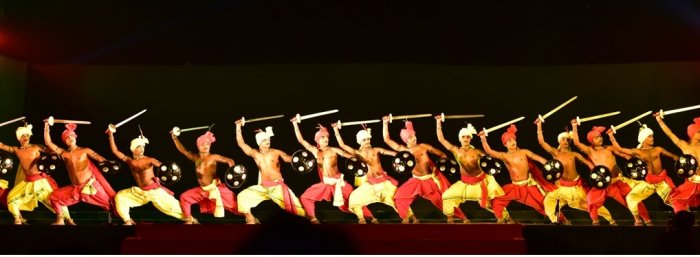 Bibhudatta Das group 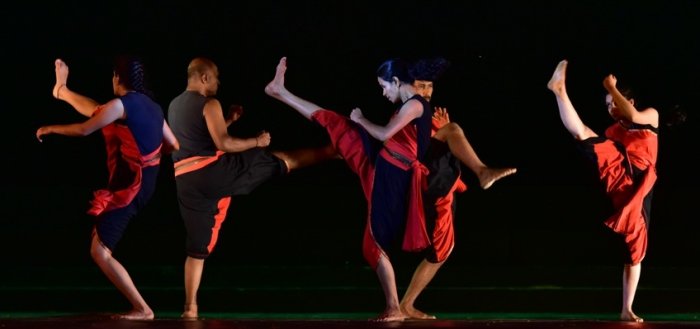 Ranjan Mullarat group The martial arts part of the festival was represented by Bibhudatta Das and group of Mayurbhanj, a revival in 2018 of what was initiated in 1968 by Maa Vairabi Chhau Nrutya Pratisthan established by the Sardar family of Mohanpur, Bholaghaty, Mayurbhanj. They presented Ruk Maar, Jodi Ranga Panda Khatriya Bandhu, Parsuram and such oft presented items. The other martial art group was Ranjan Mullarat and group presenting Kalaripayattu - interestingly with several women and youngsters in the group. Satchidananda Das is a fine mardal player working with the Odissi Research Centre for a great many years. The Mardala Badana by students from his institution, while displaying their expertise with the rare 11 matra taal (7 (4+3) +4) could have been more nuanced in the presentation. Having a sawal/jawab type of interaction between mardal playing pairs and bringing in some of the softer touches in the tala would have been more interesting than the eardrum shattering with 8 mardal players all playing together - even mardal which produces rhythm is sangeet which has to be musical. The best part of this festival has been the way various educational and training institutions send students as part of the handsome audience - an excellent way of creating a feel for our performing arts amongst the young. Among the chosen awardees for various disciplines, it was a good gesture to acknowledge the contribution of Guru Mayadhar Raut, one of the old stalwarts, with the Ruchi Buddha Samman. The Gangadhar Pradhan Smruti Samman 2019 went to Odissi vocalist Guru Ghanashyam Panda, dance Guru Aloka Kanungo, Dr. Devi Mishra for promoting Odissi in U.S.A along with Dr. Niranjan Tripathy and Dr. Swati Tripathy, and light designer Jaydev Das.  Writing on the dance scene for the last forty years, Leela Venkataraman's incisive comments on performances of all dance forms, participation in dance discussions both in India and abroad, and as a regular contributor to Hindu Friday Review, journals like Sruti and Nartanam, makes her voice respected for its balanced critiquing. She is the author of several books like Indian Classical dance: Tradition in Transition, Classical Dance in India and Indian Classical dance: The Renaissance and Beyond. Post your comments Please provide your name and email id when you use the Anonymous profile in the blog to post a comment. All appropriate comments posted with name and email id in the blog will also be featured in the site. |